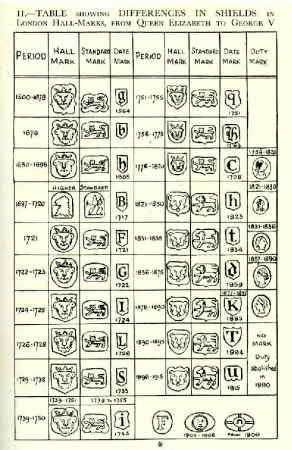|
|
LEOPARD'S HEAD
In the reign of Edward I it was decided that the fineness of
silver for both coin and wrought plate should be standardised
and thus the statute of 1300, titled "Vessels of Gold shall
be essayed, touched, and marked. The Kingís Prerogative shall be
saved" ,
was enacted making sterling (11oz 2dwt in the troy pound) that
standard for all English silver. This statute was originally
written in old Norman French, in which language the following
directive is given: "E qe nul manere de vessele de argent ne
parte hors des meins as overers tant qe ele soit assaie par les
gardiens du mester e qu ele soit signee de une teste de Leopart".
As Ďtesteí translates as head
this
passage therefore translates as: "......and that no manner of
vessel of silver depart out of the hands of the workers until it
be essayed by the Gardiens ( Wardens) of the craft, and further
that it be marked with the Leopardís Head,........")
|

The statute went on to say: ".....and that all the good
towns of England, where any goldsmith be dwelling, shall be
ordered according to this statute as they of London be;....."
and ".....and that one shall come from every good town for
all the residue that be dwelling in the same unto London; for to
be ascertained of their touch."). A
passage in the Goldsmithsí Companyís charter of 1327 contains
similar wording, although the word "fetch" instead of "ascertained"
is used, with the addition of the sentence ("Ö.also the punch
with the leopardís head with which to mark their work as was
ordained in times pastÖ.").
It can be seen from this that not only was the leopardís head a
standard mark but also that its use applied to all goldsmiths
throughout the land and not just those working in London. It was
not until 1856, when the statute of 1300 was repealed by the
statute 19 & 20 Vict. c. 64, that the leopardís head mark could
have been used for any purpose other than a fineness mark.
There appears to be no evidence that representatives from any
town did go to London to receive a punch of the Leopardís head
or that any Royal Commissioners, "responsible for assaying and
marking in cities throughout the realm" in accordance with a
statute of 1363 and an ordinance of 1379, were ever appointed. This
has caused some authorities to attribute, quite erroneously, a
dual purpose to this mark. Although it was designated as a
standard mark and applied rigorously at the London Assay Office
it appears not to have been so at other towns until the 18th
century and has thus been said to be the London mark whereas, in
fact, London had no distinguishing mark of its own at this time.
This has led to some confusion since, in its capacity as the
standard mark, it was later required to be stamped on plate
assayed at the offices at Bristol, Chester, Exeter, Norwich,
York and Newcastle when these were established at the beginning
of the 18th century.
With the exception of Chester and Exeter, both of which
offices had already ceased to use the leopardís head by 1856 and
Norwich and Bristol which had gone into decline by then, these
towns continued to strike this mark on their plate throughout
the 19th century. The last of these was Newcastle which closed
its office in 1883.
London continued to use the leopardís head on both gold and
silver of sterling standard into the 20th century and by then
was the only office so doing. It was not until 1975 however that
they first struck this mark on silver of Britannia standard so
that technically it is from that year that the leopardís head
can be truly said to be the London mark although, of course, it
can be treated as if it were the London mark for the period
between 1300 and 1697 and again between 1883 and 1975
(the author of the information about Leopard's Head is David McKinley. A wide article about this matter written by David McKinley
is available at https://www.silvercollection.it/ASCASMCKINLEYLEGAL.html )
|
 Leopard's head in London 1660 hallmark
|
 Leopard's head in Exeter 1706 hallmark
|
 Leopard's head in London 1664 hallmark
|
 Leopard's head in York c. 1800 hallmark
|
 Leopard's head in London 1675 hallmark
|
 Leopard's head in Chester 1775 hallmark
|
 Leopard's head in London 1685 hallmark
|
 Leopard's head in Chester 1800 hallmark
|
 Leopard's head in London 1692 hallmark
|
 Leopard's head in Newcastle upon Tyne 1737 hallmark
|
London 1782

|
London 1791

|
London 1795

|
London 1800

|
London 1854

|
London 1866

|
Leopard's head on Newcastle 1837 hallmark

|
London 1893

|
London 1895

|
London 1909

|
London 1912

|
London 1942

|
London 1986

|

www.silvercollection.it |
This is a page of 'The What is? Silver Dictionary' of A Small Collection of
Antique Silver and Objects of vertu, a 1500 pages richly illustrated website offering all you need to know about
antique silver, sterling silver, silverplate, Sheffield plate, electroplate silver,
silverware, flatware, tea services and tea complements, marks and hallmarks, articles,
books, auction catalogs, famous silversmiths (Tiffany, Gorham, Jensen, Elkington),
history, oddities ...
HOME - SITE MAP - SILVER DICTIONARY - COOKIES CONSENT AND PRIVACY |
| |